A house built from memory
The Mackintosh House is part of the Hunterian Art Gallery's unrivalled collection of the work of architect Charles Rennie Mackintosh (1868-1928) and his wife, Margaret Macdonald Mackintosh (1864-1933). Occupying a self-contained wing of the Gallery, it opened in 1981, and has been variously described as a 'recreation', a 're-presentation' and a 're-assemblage' of the couple's final Glasgow home. It has an unusually complex history, and one which raises challenging questions around the subject of authenticity. Here Joseph Sharples, Curator of Mackintosh Collections and Applied Art at The Hunterian, takes us through its unique history.
-
The House we see today is only the latest of three different iterations. The story begins in 1900, when the newly-married Mackintoshes moved into a tenement flat at 120 Mains Street in the centre of Glasgow. They radically transformed its mid-19th-century interiors, subtly manipulating space and proportion, and avoiding assertive colours and patterns in the treatment of walls and floors. Mackintosh designed the highly unusual chimneypieces, and also the movable furniture, which was arranged sparsely and with great care. Photographs of the remarkable interiors were published in 1901 in the leading Arts and Crafts journal The Studio, bringing them to the attention of a national – and international – audience.
In 1906 the couple left Mains Street and moved to a house in the suburb of Hillhead. Originally known as 6 Florentine Terrace, it was later renamed and renumbered to become 78 Southpark Avenue. Here Mackintosh carried out significant structural alterations, inserting new windows and knocking rooms together to create larger and more interesting spaces. However, the principal internal fixtures and most of the furniture were brought from Mains Street and carefully inserted into the Hillhead house, which was thus in some respects a modified or developed version of the earlier flat.
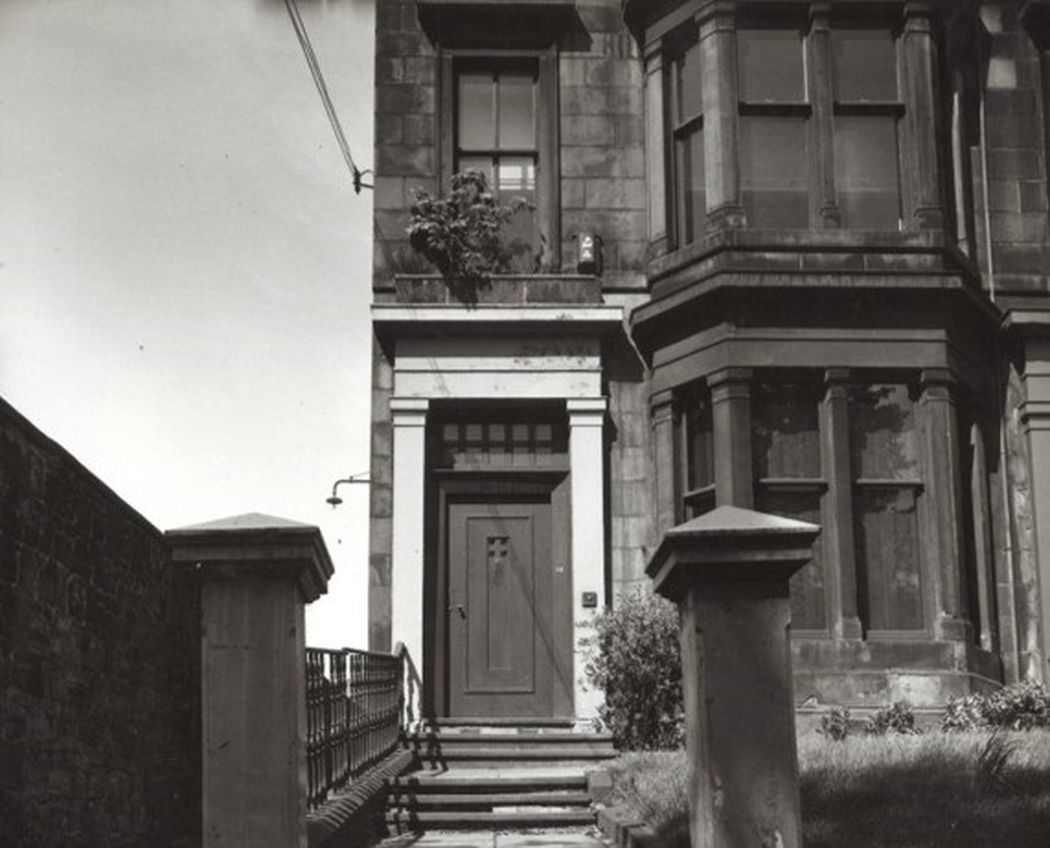
Exterior of 78 Southpark Avenue (formerly 6 Florentine Terrace) photographed in 1963, shortly before demolition (© University of Glasgow)
In 1914 the Mackintoshes left Glasgow, and 78 Southpark Avenue was later bought by Mackintosh's friend and patron, William Davidson. Following Davidson's death in 1945, his sons donated the contents to Glasgow University, and the following year the University bought the house for use as professors' lodgings.
Already in the 1940s, the idea of turning 78 Southpark Avenue into a Mackintosh museum had been raised by Thomas Howarth, the pioneering Mackintosh scholar. At the same time, Howarth anticipated that 'a permanent home for the Mackintosh collection will be provided in future extensions to the University', and he suggested the possibility of 'reconstructing the best of the Southpark Avenue interiors as a background to the exhibits.' This is approximately what came to pass, but only at the end of a long, drawn-out process lasting almost thirty years. In 1963, in order to make way for the expansion of its Hillhead campus, the University demolished 78 Southpark Avenue. This had been on the cards for some years, and at least as early as 1961 plans were under discussion for re-presenting the house in some form in a proposed University Art Gallery. The Gallery was to adjoin the new Library, and the same architect, William Whitfield, was responsible for the design of both buildings. The surviving documentation is frustratingly incomplete, and it is unclear if it was Whitfield or Andrew McLaren Young (Honorary Keeper of the University Art Collections) who had the fundamentally important idea of reconstructing the house on three floors, thus preserving the original configuration of the rooms.
-
"As early as 1961 plans were under discussion for re-presenting the house in some form"
-
Certainly Whitfield visited 78 Southpark Avenue in May 1961, and wrote immediately afterwards to the Secretary of the University Court:
'it seemed to me that the significance of Mackintosh's work would be valid only if a reconstruction included indications of the original building as he found it, and the intimate scale of the house would become meaningless if the group of rooms did not occupy their present relationships.'
A memorandum dated April 1964, presumably written by McLaren Young, includes the following description of what was already being called the Mackintosh House:
'it has already been decided that an exact replica of the interior of the Southpark Avenue terrace house remodelled by Charles Rennie Mackintosh be built as an annexe to the art building. (In Mr Whitfield's preliminary plan this [is] shown, with its original orientation, at the south-east corner). It is intended that the original Mackintosh furniture etc … be placed in the reconstructed rooms and everything arranged as it was in Mackintosh's time … '
Crucially, it was not intended to present the rooms as a series of three-sided 'boxes' all on one level, like the period rooms found in many American museums and in the V & A in London. The memorandum says explicitly that the house will extend across three floors, and that it will be taller than the rest of the art gallery. It was to be a house-within-a-gallery.
This meant that the original spatial relationships between the different rooms could be preserved. The visitor could ascend from the relative gloom of the hall and the dining room on the ground floor to the light-filled studio-drawing room on the floor above, and from there to the ethereal, white furnished bedroom at the top of the House. It meant that the rooms – only 100 metres west of their former location – would command more or less the same views. And it meant that the fall of natural light, so central in Mackintosh's approach to interior design, would be essentially the same as in Southpark Avenue.
With these plans in mind, the interiors of the doomed 78 Southpark Avenue were comprehensively recorded in photographs and measured drawings. The fixtures and fittings – fireplaces, joinery, windows, even the staircase balustrade – were then removed and put into storage, before the house itself was demolished.
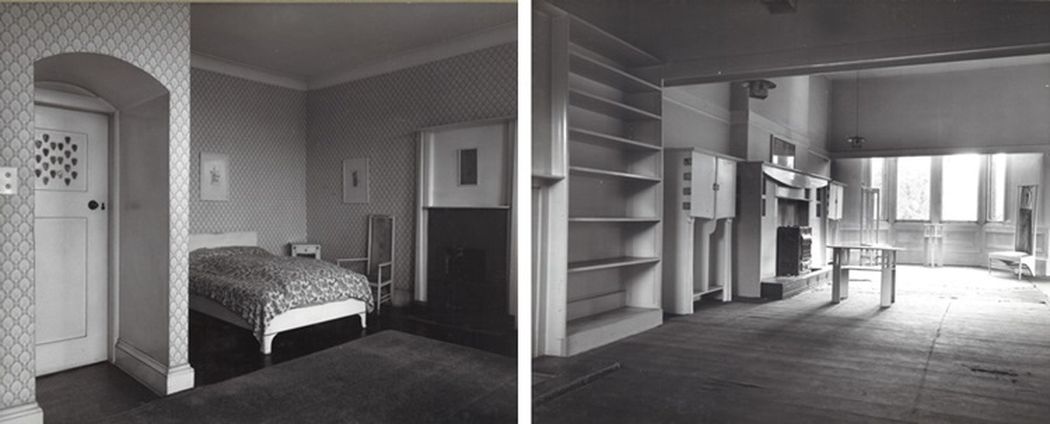
Bedroom at 78 Southpark Avenue, photographed in 1963 & Studio Drawing Room at 78 Southpark Avenue, photographed in 1963 (© University of Glasgow)
It is difficult to trace the development of Whitfield's proposals for the Mackintosh House in detail, but a set of drawing dated 1970-1971 shows the design more or less as finally built. Whitfield created a concrete box, roughly the same shape as the demolished house, into which the salvaged interiors could be fitted, with voids between the outer concrete walls and the inner stud walls providing ducts for air conditioning and services.
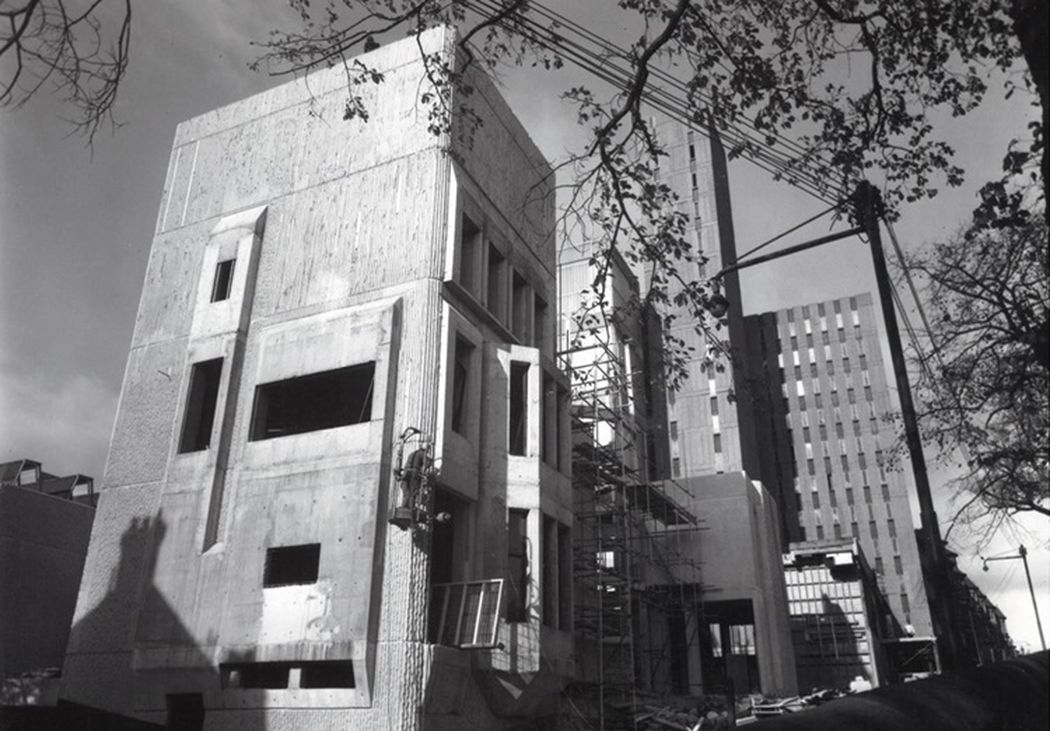
Exterior of the Mackintosh House under construction, 1974 (© University of Glasgow)
But how was the detailing of the reinstated interiors arrived at? The photographic and drawn surveys carried out in 1963 provided crucial evidence for the position of major fixtures, and for the overall shapes of the rooms. However, the house had undergone many changes between the departure of the Mackintoshes in 1914 and its demolition almost 50 years later.
-
"What had the house looked like between 1906 and 1914, when the Mackintoshes actually lived there?"
-
What had it looked like between 1906 and 1914, when the Mackintoshes actually lived there? In his 1961 letter, William Whitfield had said 'It will be necessary to do some research into the original appearance of the rooms, colour schemes and so forth, but I believe much evidence of this has survived.' In retrospect, it is clear that he underestimated the difficulties.
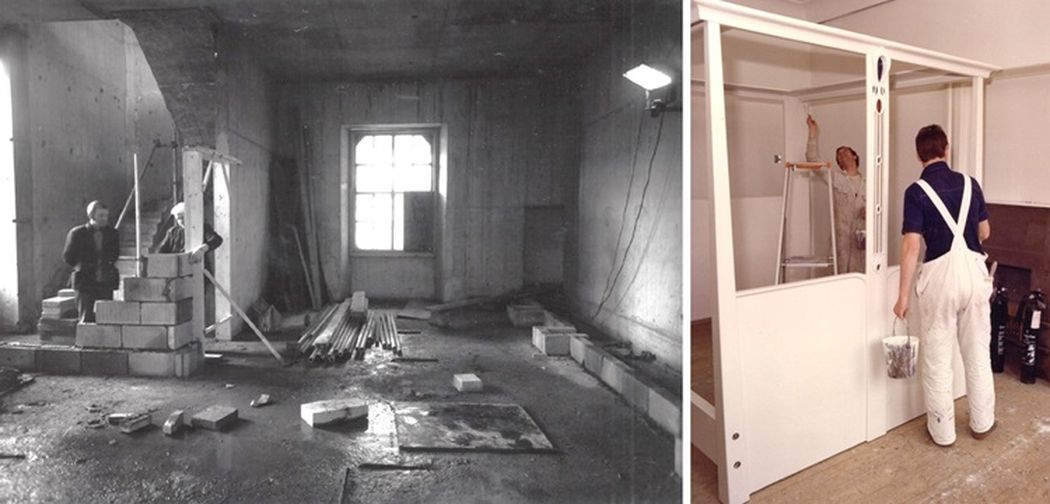
Studio Drawing Room under construction in the Mackintosh House, 1974 & decorators at work in the bedroom of the Mackintosh House, 1981 (© University of Glasgow)
The first thing to say is that no photographic evidence at all for the appearance of the rooms during the Mackintoshes' occupancy has come to light. As for architectural drawings, one set of Mackintosh's plans for 78 Southpark Avenue includes very schematic indications of the positions of major pieces of furniture, but these drawings predate the structural changes he made, which were so closely bound up with the placing of furniture in the bedroom and studio-drawing room. The excellent photographs by T. & R. Annan & Sons showing the furniture and fireplaces in their original positions at 120 Mains Street are, of course, a very important source. There are also valuable early published descriptions of the Mains Street flat by the writer E. B. Kalas, and of 78 Southpark Avenue by the Mackintoshes' friend Desmond Chapman-Huston, but their value lies more in conveying the general 'feel' of the interiors, rather than giving precise information about what was where.
So, in the absence of visual evidence, the recollections of those who had known the house, and who were still alive in the 1960s and 70s, assumed great importance. Memories, however, are fallible, and the recollections of different consultees were not always in agreement. In 1979, the then curator Pamela Robertson sent out blank line drawings of the various rooms to several witnesses, for them to annotate with their memories of colours, fabrics, etc. (this 'blank canvas' approach avoided putting ideas into their heads). Mary Newberry Sturrock, who had visited the house as a girl in the Mackintoshes' day, recalled the drawing room carpet and curtains as white, but Winifred Davidson, grand-daughter of William Davidson, thought they were green. Different again was Thomas Howarth's description of the drawing room floor as being covered in white sailcloth. These inconsistencies may have resulted from faulty memory, but equally they may be accurate accounts of the house at different times during the Mackintoshes' eight-year occupancy. We simply do not know.

Notes by Mary Newberry Sturrock on the original decoration of the Studio Drawing Room, 1979 (© University of Glasgow)
The curators were on firmer ground when personal recollections could be tied to surviving physical evidence. For instance, the wall decoration in the dining room was remembered by Hamish Davidson, and his description could be compared with fragments of the original stencilled paper. Through careful analysis of the pattern repeat and its likely relationship with the positions of items of furniture against the walls, a thoughtful, convincing, historically-based solution was arrived at. This exemplifies the admirably conservative approach to re-creating the interiors, which Pamela Robertson describes in her book about the Mackintosh House. 'The overall guiding rule for the installation was restraint: do only that for which there was documentation', she says, and she acknowledges that the result is 'certainly more severe … [and] perhaps more safe' than the interiors actually created by Mackintosh.
-
"Personal recollections could be tied to surviving physical evidence"
-
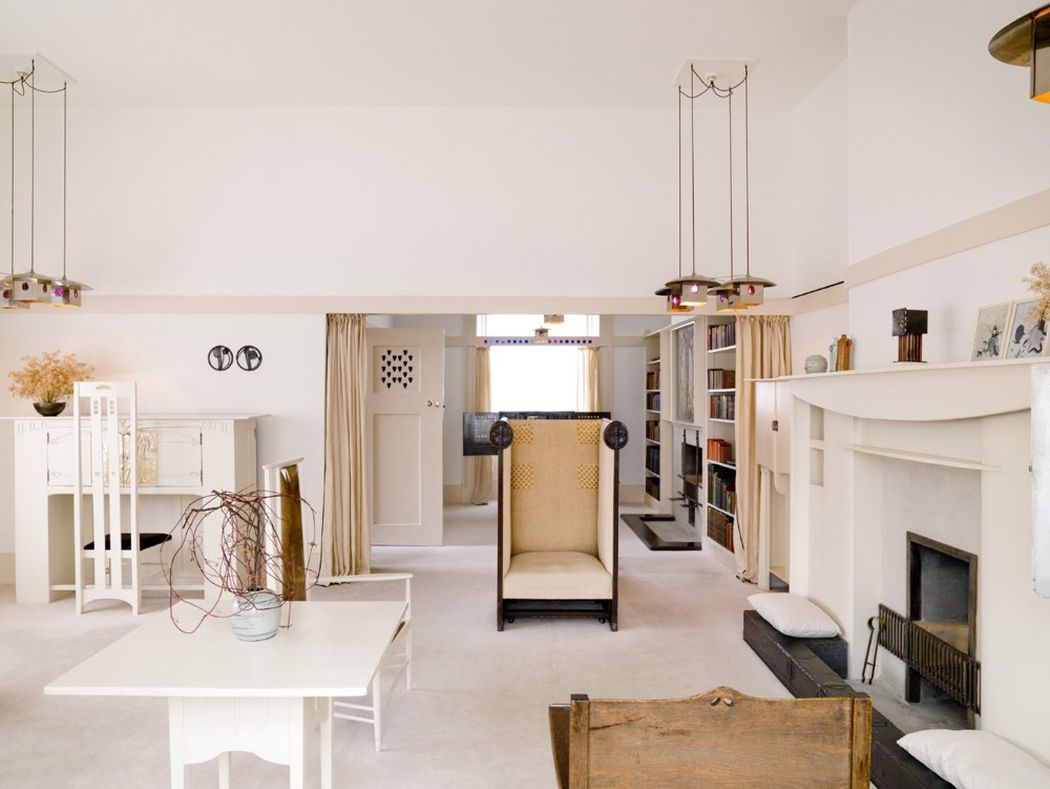
Studio Drawing Room in the Mackintosh House today (© University of Glasgow)
An enormous strength of the Mackintosh House is the exclusion of all interpretive material from the rooms. You feel as if you are visiting a house – albeit a very exceptional house – and not a museum. However, a significant drawback of this is that visitors are not necessarily aware of the status – the degree of authenticity – of what they are looking at. Nor do they necessarily understand the contrast between the exquisite, hand-crafted interiors and their brutalist concrete container. Until now, The Hunterian has relied on publications and guided tours, plus a small interpretive display in the former maid's room, to explain the complex story of the House. Many visitors, however, probably leave without absorbing any information of this kind. With the help of a grant from Museums and Galleries Scotland, The Hunterian is currently addressing this problem by planning an enhanced interpretation space just outside the House. Visitors will be able to learn more about the relationship between the Mackintosh House, 78 Southpark Avenue and 120 Mains Street, and about the challenges involved in interpreting the fragmentary evidence for the appearance of the interiors. They should leave with a better understanding of how the House achieved its present form, and hopefully their experience of this remarkable building will be enriched.
Joseph Sharples, Curator of Mackintosh Collections and Applied Art at The Hunterian
